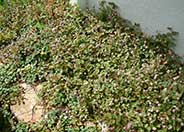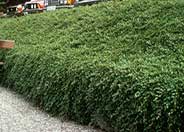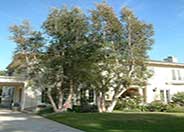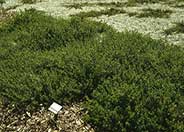
Common name:Century Plant, Maguey
Botanical name:Agave americana
This plant is fast growing to about 6'-10' tall and 8'-13' wide. Wide gray leaves have stiff terminal spines and recurved teeth on margins. It prefers full sun and well-drained situations. After blooming, which could take several years, it will die but will send up new pups from around the base. Some people are allergic to the sap. Removal is difficult if unwanted.

Common name:Pink Knotweed
Botanical name:Persicaria capitata
Persicaria capitata has an attractive bronze-green foliage, with masses of pink flowers on this trailing plant. It grows 6"-8" high. It blooms most of the time. It is very tender to frost but will grow vigorously with adequate water during warm weather. It makes a good groundcover, rooting along as runners spread. Plant 12" apart.

Common name:Bearberry Cotoneaster
Botanical name:Cotoneaster dammeri
This prostrate, trailing evergreen shrub is primarily used as a ground cover. It is highlighted with bright green, ovate to rounded leaves with prominent veins. In the fall, Bearberry Cotoneasters are accented by small, bright red berries.

Common name:Paperbark Tree, Cajeput Tree
Botanical name:Melaleuca quinquenervia
Paperbark or Cajeput (Melaleuca quinquenervia) is an Australian native that is known for its beautiful, papery bark that unravels in sheets on the trunk. The tree can reach 40’ tall and 15’-25’ wide. It is often grown as a multi-trunk tree, and it makes a beautiful specimen tree in a wide range of garden styles. It is unparticular about its soil, and it can thrive in a wide range of moisture conditions. If this tree is selected for a small- to medium-sized garden, measures must be taken to keep topical roots from forming. Drip irrigation or deep, infrequent watering is best. If this tree is planted near an area with overhead sprinklers, root barriers may be necessary to keep roots away from the wetter parts of the garden. Once the tree reaches a size where it could benefit from some shaping, it is best to have a licensed arborist perform the work. This tree should be planted at least eight feet away from any hardscape areas, 15 feet from structures such as houses and buildings, and not near any powerlines. Shrubs and perennials should be planted about five feet away from this tree. It should be irrigated for about 45 minutes once a week when using most in-line drip irrigation systems.

Common name:Coyote Bush
Botanical name:Baccharis pilularis 'Pigeon Point'
'Pigeon Point' is a compact, evergreen ground cover that grows 18"- 24" tall and 10'-12' wide. It is the preferred form of the Coyote Bush. Its leaves are green; it has white flowers that bloom in the fall. It is important to plant this groundcover that are at least 6' -10' apart. Otherwise they will overgrow each other and create a high groundcover. 'Pigeon Point' is tolerant of ocean spray and is deer resistant.
Photographer: GardenSoft
Maintain a two to four inch layer of mulch on the soil surface to reduce weeds, infiltrate rain water, and reduce compaction.
Drip and other smart irrigation delivers water directly to roots, allowing no excess water for weeds.